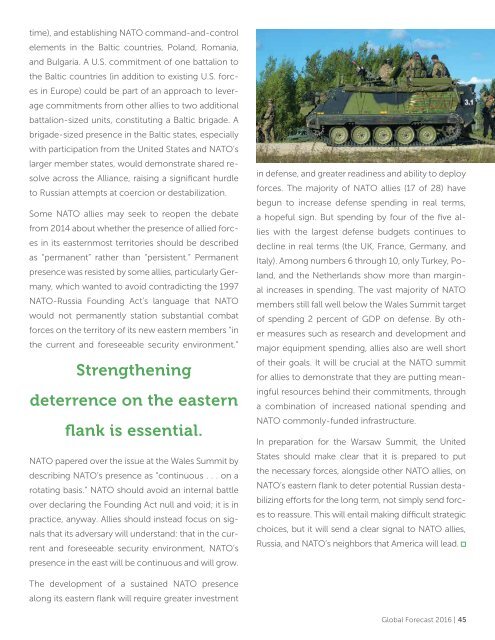You also want an ePaper? Increase the reach of your titles
YUMPU automatically turns print PDFs into web optimized ePapers that Google loves.
time), and establishing NATO command-and-control<br />
elements in the Baltic countries, Poland, Romania,<br />
and Bulgaria. A U.S. commitment of one battalion to<br />
the Baltic countries (in addition to existing U.S. forces<br />
in Europe) could be part of an approach to leverage<br />
commitments from other allies to two additional<br />
battalion-sized units, constituting a Baltic brigade. A<br />
brigade-sized presence in the Baltic states, especially<br />
with participation from the United States and NATO’s<br />
larger member states, would demonstrate shared resolve<br />
across the Alliance, raising a significant hurdle<br />
to Russian attempts at coercion or destabilization.<br />
Some NATO allies may seek to reopen the debate<br />
from 2014 about whether the presence of allied forces<br />
in its easternmost territories should be described<br />
as “permanent” rather than “persistent.” Permanent<br />
presence was resisted by some allies, particularly Germany,<br />
which wanted to avoid contradicting the 1997<br />
NATO-Russia Founding Act’s language that NATO<br />
would not permanently station substantial combat<br />
forces on the territory of its new eastern members “in<br />
the current and foreseeable security environment.”<br />
Strengthening<br />
deterrence on the eastern<br />
flank is essential.<br />
NATO papered over the issue at the Wales Summit by<br />
describing NATO’s presence as “continuous . . . on a<br />
rotating basis.” NATO should avoid an internal battle<br />
over declaring the Founding Act null and void; it is in<br />
practice, anyway. Allies should instead focus on signals<br />
that its adversary will understand: that in the current<br />
and foreseeable security environment, NATO’s<br />
presence in the east will be continuous and will grow.<br />
in defense, and greater readiness and ability to deploy<br />
forces. The majority of NATO allies (17 of 28) have<br />
begun to increase defense spending in real terms,<br />
a hopeful sign. But spending by four of the five allies<br />
with the largest defense budgets continues to<br />
decline in real terms (the UK, France, Germany, and<br />
Italy). Among numbers 6 through 10, only Turkey, Poland,<br />
and the Netherlands show more than marginal<br />
increases in spending. The vast majority of NATO<br />
members still fall well below the Wales Summit target<br />
of spending 2 percent of GDP on defense. By other<br />
measures such as research and development and<br />
major equipment spending, allies also are well short<br />
of their goals. It will be crucial at the NATO summit<br />
for allies to demonstrate that they are putting meaningful<br />
resources behind their commitments, through<br />
a combination of increased national spending and<br />
NATO commonly-funded infrastructure.<br />
In preparation for the Warsaw Summit, the United<br />
States should make clear that it is prepared to put<br />
the necessary forces, alongside other NATO allies, on<br />
NATO’s eastern flank to deter potential Russian destabilizing<br />
efforts for the long term, not simply send forces<br />
to reassure. This will entail making difficult strategic<br />
choices, but it will send a clear signal to NATO allies,<br />
Russia, and NATO’s neighbors that America will lead.<br />
The development of a sustained NATO presence<br />
along its eastern flank will require greater investment<br />
Global Forecast 2016 | 45


